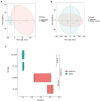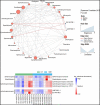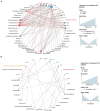Evaluation of environmental factors and microbial community structure in an important drinking-water reservoir across seasons
- PMID: 36865780
- PMCID: PMC9971975
- DOI: 10.3389/fmicb.2023.1091818
Evaluation of environmental factors and microbial community structure in an important drinking-water reservoir across seasons
Abstract
The composition of microbial communities varies in water and sediments, and changes in environmental factors have major effects on microbiomes. Here, we characterized variations in microbial communities and physicochemical factors at two sites in a large subtropical drinking water reservoir in southern China. The microbiomes of all sites, including the diversity and abundance of microbial species, were determined via metagenomics, and the relationships between microbiomes and physicochemical factors were determined via redundancy analysis. The dominant species in sediment and water samples differed; Dinobryon sp. LO226KS and Dinobryon divergens were dominant in sediment samples, whereas Candidatus Fonsibacter ubiquis and Microcystis elabens were dominant in water. The diversity was also significantly different in microbial alpha diversity between water and sediment habitats (p < 0.01). The trophic level index (TLI) was the major factor affecting the microbial community in water samples; Mycolicibacterium litorale and Mycolicibacterium phlei were significantly positively related to TLI. Furthermore, we also studied the distribution of algal toxin-encoding genes and antibiotic-resistant genes (ARGs) in the reservoir. It found that water samples contained more phycotoxin genes, with the cylindrospermopsin gene cluster most abundant. We found three genera highly related to cylindrospermopsin and explored a new cyanobacteria Aphanocapsa montana that may produce cylindrospermopsin based on the correlation through network analysis. The multidrug resistance gene was the most abundant ARG, while the relationship between ARGs and bacteria in sediment samples was more complicated than in water. The results of this study enhance our understanding of the effects of environmental factors on microbiomes. In conclusion, research on the properties, including profiles of algal toxin-encoding genes and ARGs, and microbial communities can aid water quality monitoring and conservation.
Keywords: cylindrospermopsins (CYNs); metagoenomics; multidrug resistance genes; subtropical drinking water source; trophic level index (TLI).
Copyright © 2023 Feng, Zhou, Zhao, Chen, Li, Liu, Ou, Xie, Wang, Yin, Zhang, Li, Luo, Zeng, Yan, Xie and Sun.
Conflict of interest statement
LS, LZho, YLiu, XZhao, MW, XZhan, YLi, ML, LZen, and QY were employed by GeneMind Biosciences Company Limited. JF, JC, ZL, LO, ZX, XY, and LX were employed by the State Environmental Protection Key Laboratory of Drinking Water Source.
Figures








Similar articles
-
Antibiotic resistomes in water supply reservoirs sediments of central China: main biotic drivers and distribution pattern.Environ Sci Pollut Res Int. 2022 May;29(25):37712-37721. doi: 10.1007/s11356-021-18095-w. Epub 2022 Jan 23. Environ Sci Pollut Res Int. 2022. PMID: 35066838
-
Distribution and drivers of antibiotic resistance genes in brackish water aquaculture sediment.Sci Total Environ. 2023 Feb 20;860:160475. doi: 10.1016/j.scitotenv.2022.160475. Epub 2022 Nov 24. Sci Total Environ. 2023. PMID: 36436623
-
Exploring the differences of antibiotic resistance genes profiles between river surface water and sediments using metagenomic approach.Ecotoxicol Environ Saf. 2018 Oct;161:64-69. doi: 10.1016/j.ecoenv.2018.05.044. Epub 2018 May 30. Ecotoxicol Environ Saf. 2018. PMID: 29859409
-
Sediment enzyme activities and microbial community diversity in an oligotrophic drinking water reservoir, eastern China.PLoS One. 2013 Oct 25;8(10):e78571. doi: 10.1371/journal.pone.0078571. eCollection 2013. PLoS One. 2013. PMID: 24205265 Free PMC article.
-
Profiles of Microbial Community and Antibiotic Resistome in Wild Tick Species.mSystems. 2022 Aug 30;7(4):e0003722. doi: 10.1128/msystems.00037-22. Epub 2022 Aug 1. mSystems. 2022. PMID: 35913190 Free PMC article. Review.
Cited by
-
Molecular Screening for Cyanobacteria and Their Cyanotoxin Potential in Diverse Habitats.Toxins (Basel). 2024 Jul 27;16(8):333. doi: 10.3390/toxins16080333. Toxins (Basel). 2024. PMID: 39195743 Free PMC article.
-
Comparative analysis of antibiotic resistance genes between fresh pig manure and composted pig manure in winter, China.PLoS One. 2025 Jan 29;20(1):e0317827. doi: 10.1371/journal.pone.0317827. eCollection 2025. PLoS One. 2025. PMID: 39879247 Free PMC article.
-
Identifying spatiotemporal patterns and drivers of fecal indicator bacteria in an urban lake for water quality assessment and management.Heliyon. 2024 Dec 11;11(1):e40955. doi: 10.1016/j.heliyon.2024.e40955. eCollection 2025 Jan 15. Heliyon. 2024. PMID: 39807522 Free PMC article.
-
Extreme trophic tales: deciphering bacterial diversity and potential functions in oligotrophic and hypereutrophic lakes.BMC Microbiol. 2024 Sep 14;24(1):348. doi: 10.1186/s12866-024-03488-x. BMC Microbiol. 2024. PMID: 39277721 Free PMC article.
References
-
- Alcamo J. (2019). Water quality and its interlinkages with the Sustainable Development Goals. Curr. Opin. Environ. Sustain. 36, 126–140. doi: 10.1016/j.cosust.2018.11.005 - DOI
LinkOut - more resources
Full Text Sources

